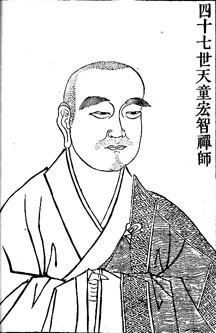Role Author | Title Chan master Name Hongzhi Zhengjue | |
 | ||
Hongzhi Zhengjue (Chinese: 宏智正覺; pinyin: Hongzhi Zhengjue; Wade–Giles: Hung-chih Cheng-chueh, Japanese: Wanshi Shogaku), also sometimes called Tiantong Zhengjue (Chinese: 天童正覺; Japanese: Tendo Shogaku) (1091–1157), was a Chinese Chan (Japanese: Zen) Buddhist monk who authored or compiled several influential Buddhist texts. Hongzhi's conception of silent illumination is of particular importance to the Chinese Caodong Chan and Japanese Soto Zen schools; however, Hongzhi was also the author of an important collection of koans, although koans are now usually associated with the Chinese Linji or Japanese Rinzai schools.
Contents
Life
According to the account given in Taigen Dan Leighton's Cultivating the Empty Field, Hongzhi was born to a family named Li in Xizhou, present-day Shanxi province. He left home at the age of eleven to become a monk, studying under Caodong master Kumu Faqeng, among others, including Yuanwu Keqin, author of the famous koan collection, the Blue Cliff Record.
In 1129, Hongzhi began teaching at the Jingde monastery on Mount Tiantong, where he remained for nearly thirty years, until shortly before his death in 1157, when he ventured down the mountain to bid farewell to his supporters.
Texts
The main text associated with Hongzhi is a collection of one hundred of his koans, known in English as The Book of Equanimity, The Book of Serenity, or The Book of Composure (Chinese: 從容録; pinyin: Congrong Lu), or Shoyoroku (従容録) in Japanese. This book was compiled after his death by Wansong Xingxiu (1166–1246) at the urging of the Khitan statesman Yelu Chucai (1190–1244), and first published in 1224, with commentaries by Wansong. This book is regarded as one of the key texts of the Caodong school of Zen Buddhism. A collection of Hongzhi's philosophical texts has also been translated by Leighton.
Hongzhi is often referred to as an exponent of Silent Illumination Chan (Mokusho Zen 黙照禅 in Japanese).
Aside from his own teacher, Eihei Dogen—the founder of the Soto school of Zen in Japan—quotes Hongzhi in his work more than any other Zen figure.
